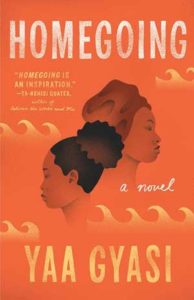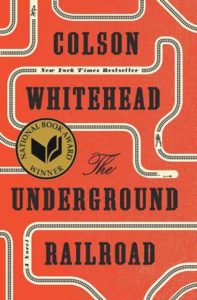Homegoing: A Novel and The Underground Railroad: A Novel
Two titles reviewed by Lauren Brownlee
September 1, 2017
 Homegoing: A Novel. By Yaa Gyasi. Knopf, 2016. 320 pages. $26.95/hardcover; $16/paperback; $11.99/eBook.
Homegoing: A Novel. By Yaa Gyasi. Knopf, 2016. 320 pages. $26.95/hardcover; $16/paperback; $11.99/eBook.
Buy from QuakerBooks
The Underground Railroad: A Novel. By Colson Whitehead. Doubleday, 2016. 320 pages. $26.95/hardcover; $27/paperback; $13.99/eBook.
Buy from QuakerBooks
As a history teacher, I find the real world the greatest story of all. In recent years, however, I have come to appreciate how fiction can help us gain a new perspective and spark our imagination as we work to shape this real world. As a black woman, I have appreciated the many stories in recent years that have given us a window into the lives that my enslaved ancestors endured. After I saw the film 12 Years a Slave, I sat and sobbed in my car, so grateful for my life and committed to living in a way that truly honors the dreams of those who paved the way. Both Homegoing: A Novel by Yaa Gyasi and The Underground Railroad: A Novel by Colson Whitehead similarly bring us face to face with our history, however we define that—ethnic, national, or global. Whitehead writes in Underground Railroad that “Nobody wanted to speak on the true disposition of the world. And no one wanted to hear it.” Both Whitehead and Gyasi are brave souls willing to show us the extent to which we are shaped by our history, whether or not we want to hear it, because only by facing our past can we build a different future.
Homegoing beautifully weaves together the stories of one African family through two separate branches of their family tree, beginning with half-sisters in eighteenth-century Ghana. One marries a British officer and lives in the Cape Coast Castle, while the other is shackled in the dungeon below the castle as she waits to be shipped to the United States. Each chapter is from a new character’s perspective, always moving forward a generation through alternating branches of the family tree. In Ghana we learn about the pain that war and slavery inevitably bring, the challenges of lives that are guided by custom, and counterproductive missionary work. In the United States we bear witness to slavery, the beginnings of mass incarceration during Reconstruction, the difficulty of finding housing and employment during the Great Migration, and the struggles of the Civil Rights Movement. The book speaks meaningfully to the impact of one generation on the next while also showing the power of individuals to break the cycles into which they were born.
Homegoing is excellent historical fiction. Gyasi took great care to research each of the periods that serve as the backdrops to chapters of the book. In her presentation of this history, she has chosen to include a fair amount of attention to the role that Africans played in the slave trade and to the fact that African families would use and abuse those enslaved from other ethnic groups, particularly those captured in war. Some people have deduced from this focus of the book that Americans need not be ashamed of our own history of slavery. Gyasi takes great pains to make it clear that that is not her point. She gives Ghanaian characters close to the slave trade dialogue such as, “The way they treat the slaves in America . . . It is unfathomable. Unfathomable. We do not have slavery like that here. Not like that.” Later, another Ghanaian character recognizes that, “Everyone was responsible. We all were . . . we all are.” Gyasi’s point is not that anyone should feel guilty about slavery, or any other periods of our history, but that we must acknowledge the impact of history on the contemporary world.
 As Homegoing travels through time, The Underground Railroad travels through space. Its protagonist, Cora, escapes slavery and visits, via a literal underground railroad, different places across the United States, each of which Whitehead has said represents a different set of possibilities. Cora begins in Georgia, where she suffers the cruelties of slavery, then visits South Carolina with its “mission of colored uplift, especially for those with aptitude,” then goes to North Carolina where they clarify that they have not abolished slavery but “abolished n*ggers,” by literally forcing them out, and then Indiana where she finds a community of blacks caring for each other while knowing that their success infuriates the whites around them. A friend of mine recently shared that she believes that everyone should read Underground Railroad before Homegoing in order to fully appreciate it. I think she’s spot on. After reading the meticulous historical detail of Homegoing, the intentional playing with history that Underground Railroad engages in feels less true. When I recently reread Underground Railroad without Homegoing’s chronology in my head, I appreciated the genius of its language and imagery for the first time and understood why it deserved the National Book Award and the Pulitzer Prize.
As Homegoing travels through time, The Underground Railroad travels through space. Its protagonist, Cora, escapes slavery and visits, via a literal underground railroad, different places across the United States, each of which Whitehead has said represents a different set of possibilities. Cora begins in Georgia, where she suffers the cruelties of slavery, then visits South Carolina with its “mission of colored uplift, especially for those with aptitude,” then goes to North Carolina where they clarify that they have not abolished slavery but “abolished n*ggers,” by literally forcing them out, and then Indiana where she finds a community of blacks caring for each other while knowing that their success infuriates the whites around them. A friend of mine recently shared that she believes that everyone should read Underground Railroad before Homegoing in order to fully appreciate it. I think she’s spot on. After reading the meticulous historical detail of Homegoing, the intentional playing with history that Underground Railroad engages in feels less true. When I recently reread Underground Railroad without Homegoing’s chronology in my head, I appreciated the genius of its language and imagery for the first time and understood why it deserved the National Book Award and the Pulitzer Prize.
Perhaps one of the most telling passages in The Underground Railroad comes as Cora sets out on her journey. She is directed to “Look outside as you speed through [the tunnels of the underground railroad], and you’ll find the true face of America.” When she looks out, she sees “only darkness, mile after mile.” That seems to be the thesis of the book—there is no escape from slavery and its legacy of racism and brutality. Throughout the United States, Cora finds only white supremacy. It comes in the form of condescension with a smile, derogatory language, and the refusal to acknowledge her humanity. Over the course of her journey, she sees black bodies being used for research, for population control, and ultimately, their corpses hung up as warning. At one point Cora determines that “there [a]re no places to escape to, only places to flee.” She seems to represent Whitehead’s reflections on not only a distinct period of American history but also the world he faces today.
As Gyasi and Whitehead “speak on the true disposition of the world,” they illuminate the tunnel of history for their readers. Each book has a scene in which a sanitized version of slavery is performed for a white audience. In The Underground Railroad this includes Cora sitting at a spinning wheel as a human exhibit in the Museum of Natural Wonders, and in Homegoing there is a jazz show in which actors portraying enslaved men sing about how lazy they are and how lucky they are to have such generous masters. These scenes serve as reminders that we may not want to see the ugliness of our past, but the false stories we tell ourselves are laughable. Toward the end of each book, the authors explicitly acknowledge that the tension between blacks and whites in the United States comes from the cumulative history explored in these works. In Homegoing there is a character who “was forever talking about slavery, the prison labor complex, the System, segregation, the Man. [He] had a deep-seated hatred of white people,” while Underground Railroad simply states, “The Great War had always been between the white and the black. It always would be.” We cannot recognize continuing revelation without leaning into discomfort.
Ultimately, both stories offer the hope of a better future, for those in their imagined worlds and for those of us in this real one. They have storylines that demonstrate how often we are driven by fear, but also storylines that feature the power of love to change the course of history. There are no innocent bystanders in these books; they demand that we understand the significance of the agency that we each possess. We must acknowledge the past, mourn for its darkness, and then build a world of light as we answer that of God in every one.



Comments on Friendsjournal.org may be used in the Forum of the print magazine and may be edited for length and clarity.